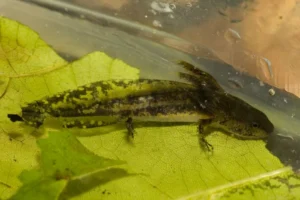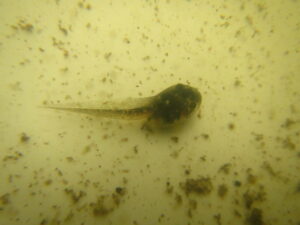Freshwater ponds and streams are home to many different animals. Among these creatures, salamanders stand out as some of the most interesting. These small amphibians have smooth, wet skin and can live both in water and on land. People often wonder about their eating habits, especially whether they eat frog tadpoles. This question helps us understand how different animals interact in nature.
Yes, some salamanders do eat tadpoles. But it’s not their main food, and not all salamanders do this. Larger salamanders and larvae sometimes eat tadpoles, especially when other food is scarce.
This is part of nature’s balance in ponds and streams.
The Life of a Salamander
To understand what salamanders eat, we need to know about their life stages. Salamanders go through several changes as they grow up.
First, adult salamanders lay their eggs. Most species lay eggs in water or in very wet places on land. The eggs are soft and jelly-like, not hard like bird eggs.
When the eggs hatch, baby salamanders come out. These babies are called larvae. They look quite different from adult salamanders.
They have gills to breathe underwater, just like fish. They also have fins to help them swim. These young salamanders live in water and eat small water animals.

As the larvae grow, they go through big changes. They develop lungs to breathe air. Their gills disappear. They grow stronger legs and lose their fins.
This change is called metamorphosis. After this change, young salamanders can live on land, though many still spend time in water.
Adult salamanders are fully grown and can reproduce. They continue to hunt small animals throughout their lives. Some adults live mostly on land, while others stay in water most of the time.
Do Salamanders Really Eat Tadpoles?
The answer is yes, but it is not simple. Some salamanders do eat tadpoles, but not all salamanders do this. Whether a salamander eats tadpoles depends on many factors.
The size of the salamander matters a lot. Larger salamanders like tiger salamanders and ringed salamanders have been seen eating frog tadpoles in ponds and wetlands.

Research shows that salamander larvae of species such as Hynobius retardatus can prey on tadpoles and even induce defensive shape changes.
Observations confirm predation by European fire salamander larvae on frog tadpoles.
Even young salamanders can eat tadpoles. When salamander larvae grow bigger, they sometimes eat smaller tadpoles. This happens more often when there is not much other food available.
The type of salamander also matters. Some species are more likely to eat tadpoles than others. Salamanders that live in the same water as frogs and toads are more likely to encounter tadpoles and eat them.
When Salamanders Choose Tadpoles
Several things affect whether a salamander will eat tadpoles. Understanding these factors helps us see how nature works.
Size is very important. A small salamander cannot eat a large tadpole. But a big salamander can easily catch and eat small tadpoles.
The availability of other food plays a big role. If there are plenty of insects, worms, and other small animals around, salamanders might ignore tadpoles completely. But when food is hard to find, salamanders become less picky.
The environment also matters. In clear, warm water, salamanders might be more active and hunt more often. In cold or muddy water, they might be less active and eat less. The amount of plants and hiding places in the water can affect how easy it is for salamanders to find and catch tadpoles.
Salamanders can smell chemicals in the water that tadpoles release. A study shows that tiger salamander larvae respond to tadpole alarm cues. But if there are other predators around, salamanders might change their hunting behavior. They might hunt less often or look for different types of prey.
Effects on Tadpole Numbers
When salamanders and frogs live in the same pond, salamanders can reduce the number of tadpoles through hunting. This might seem bad for frogs, but it actually helps keep the ecosystem healthy.
If there were no salamanders to eat some tadpoles, frog populations might grow too large. Too many tadpoles in one pond can cause problems. They might eat all the food available, leaving nothing for other animals. They might also make the water less healthy.
By eating some tadpoles, salamanders help prevent any one species from taking over the pond. This creates space and resources for other animals to live and grow. The result is a more balanced ecosystem with many different types of animals.
Tadpoles Are Important Too
While salamanders sometimes eat tadpoles, tadpoles are not just prey animals. They play important roles in their water homes. Most tadpoles eat algae and small plants in the water. This helps keep the water clean and healthy.
Tadpoles also serve as food for many other animals besides salamanders. Birds, fish, snakes, and other amphibians eat tadpoles. This makes tadpoles an important part of the food web in freshwater areas.
The relationship between salamanders and tadpoles is just one small part of a much larger system. Both animals are important for keeping their water homes healthy and balanced.
Natural Balance
The fact that salamanders sometimes eat tadpoles is part of how nature stays in balance. Neither salamanders nor frogs are trying to hurt each other. Instead, they help control each other’s populations in a way that keeps the ecosystem working well.
In places where salamanders are missing or very rare, some frog species can become too common. This can upset the balance of the ecosystem. Too many of any one animal can cause problems for other species.
Salamanders act as natural controllers in their ecosystems. They are not just predators but also help maintain the health of their water homes. This is why scientists consider salamanders important indicator species. Their presence often shows that an ecosystem is healthy.
Conclusion
So, do salamanders eat tadpoles? Sometimes they do. But tadpoles are not their main food, and not all salamanders eat them. Salamanders are opportunistic hunters. This means they eat whatever prey they can find and catch.
Whether a salamander eats tadpoles depends on the salamander’s size, the availability of other food, and the conditions in their environment. Larger salamanders are more likely to eat tadpoles, especially when other food is scarce.
This natural predation is one of many ways that life stays balanced in ponds, wetlands, and streams. Both salamanders and tadpoles have important jobs in keeping their ecosystems healthy.
The next time you see a salamander near water or hiding under a log, remember that you are looking at an important part of nature’s balance.

